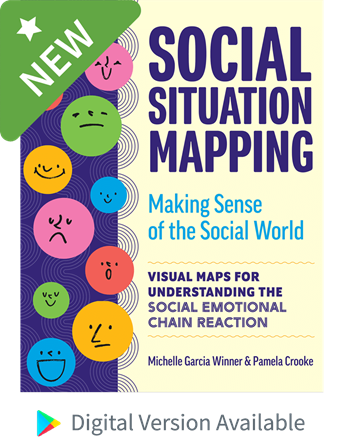
Click image to zoom.
Double click image to zoom.




- Ages: 8+
- Pages: 108
- Format: Paperback
- ISBN: 9781936943944
- Published: 2023
Description
Digital version must be purchased separately—only on Google Play.
Helping Learners Understand and Make Choices in the Social World
Download The 10-Step Visual Fidelity and Teaching Guide.
What’s happening around us influences our thoughts, feelings, and responses. Social Situation Mapping (formerly Social Behavior Mapping), a core teaching framework within the Social Thinking® Methodology, uses visual templates to encourage learners to engage social observation for figuring out what to do and say (or not do and say) based on a particular situation: where we are, who is present, and what is happening. The maps also outline a fundamental teaching framework we call the Social Emotional Chain Reaction, which shows how we all impact one another when sharing space. The maps are meant to be taught from the perspective of the student or client to provide options for what to do or say in common situations. We encourage educators, therapists, and parents to jointly generate unique maps alongside the student or client based on their individual goals.
Revised, retitled, and updated with our most current teaching, Social Situation Mapping includes:
- 80+ completed Social Situation Maps (SSMs) to explore 40+ practical everyday situations that happen at school, home, and in the community.
- Maps with blank spaces for students to add their own ideas and observations.
- Maps with options to honor neurodivergent choices or strategies. Some options are also inclusive of learning differences and/or disabilities.
- One blank map template that can be photocopied and used again and again. The completed maps within this book can also be used as guideposts as learners generate their own maps and figure out a path through the lens of their social goals or desires.
- A description of the Social Emotional Chain Reaction (SECR), the foundational concept taught in Social Situation Mapping.
- The 10-Step Visual Fidelity and Teaching Guide.
Recommended Teaching & Learning Pathway
Social Situation Mapping is more powerful when taught with other materials. Teaching social concepts should follow a natural sequence, from simple to complex, to support student learning. The following Teaching & Learning Pathway outlines the recommended teaching sequence by age group. As with our products, this pathway is relevant to clinicians, educators, parents—anyone helping a person develop their social competencies.
- Core Methodology: All Ages
- Ages 4-10
- Ages 10-18
Related Materials


Instructor: Michelle Garcia Winner
Explore expected and unexpected behavior based on the situation in the sixth webinar in our 10 Concepts series. Discover how to use these terms with fidelity in order to teach individuals to figure out the hidden or unspoken expectations across different social contexts. Note: The terms Expected and Unexpected behaviors do not mean the same as appropriate/inappropriate or good/bad (even if you’ve heard people use them in that way)!


Social Situation Mapping: Making Sense of the Social World
Tell us something good!
There was a problem adding this comment. Plaease try later.
Please log in